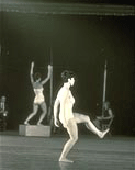The label 'pioneer' gets applied fairly liberally to artists working with emerging technologies or scientists pursuing aesthetic applications for their inquiries. This term would be an understatement when it comes to E.A.T (Experiments in Art and Technology), the organization founded in October of 1966, by Bell Telephone research scientist Billy Kluver. The group indisputably created the Ur-text for contemporary technology-enabled performance. Their '9-Evenings: Theater & Engineering,' was a program of work by 10 artists--including Robert Rauschenberg, John Cage, and Yvonne Rainer--made in collaboration with a group of 30 engineers and scientists who tailored then-innovative equipment, such as fiber-optic cameras and Doppler sonar, to the artists' projects. As legendary as the events have become, documentation of the performances has been hard to find--until now. Beginning on February 27th, E.A.T., Artpix, and Microcinema International will begin releasing a 10-part DVD series that documents each performance with archival sound recordings and film. The first release will be Robert Rauschenberg's 'Open Score,' the historic tennis match played using racquets equipped with portable FM transmitters, which climaxes with infrared video footage of a crowd swarming the pitch-black court. The second disk in the series comes out on June 26, but in the meantime, clips on the project's website offer an interim fix of excavated and lovingly-assembled footage. - Bill Hanley
